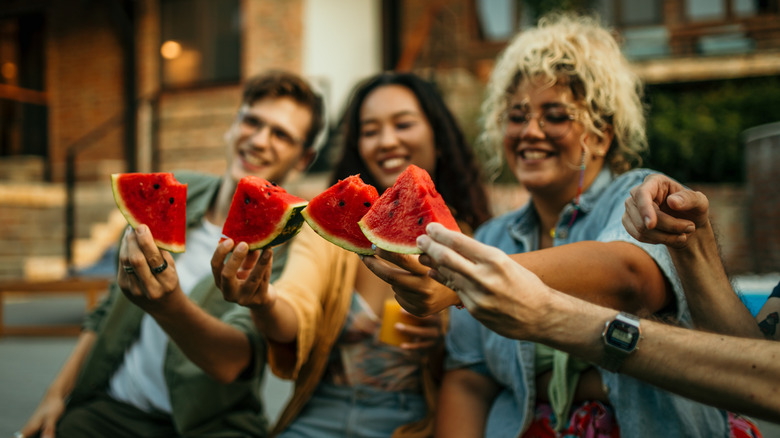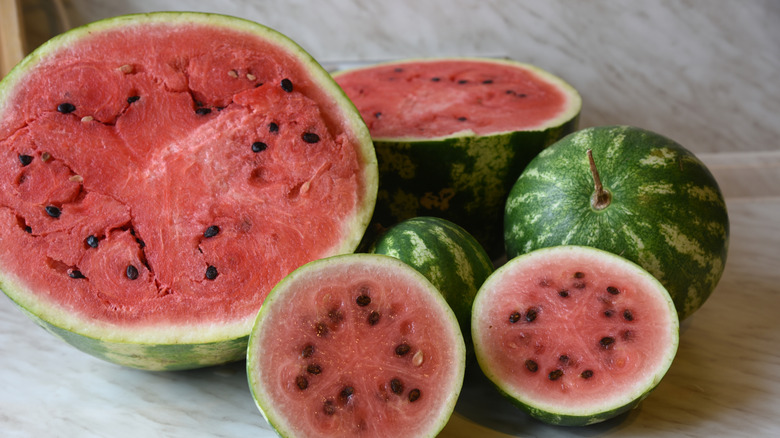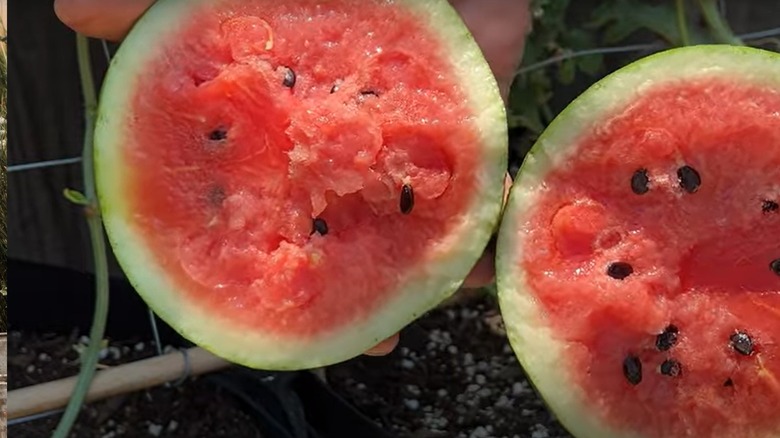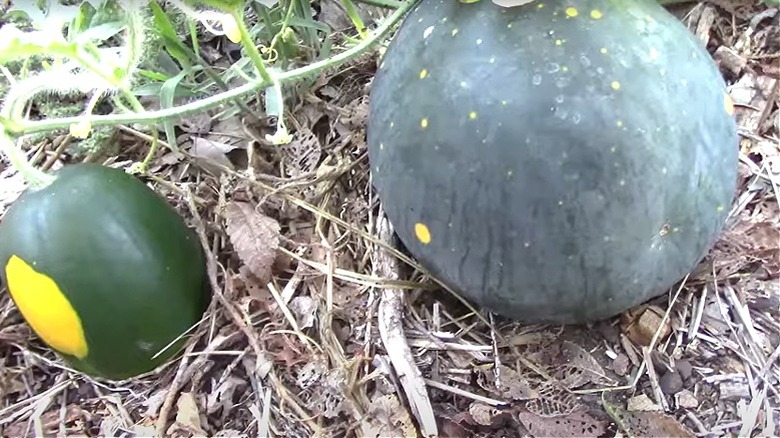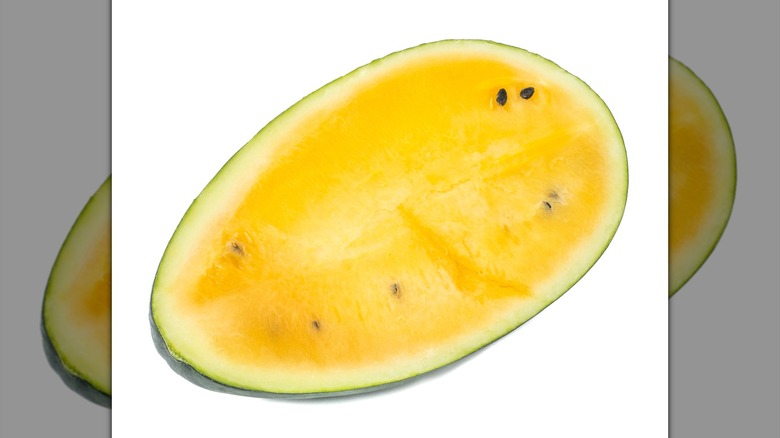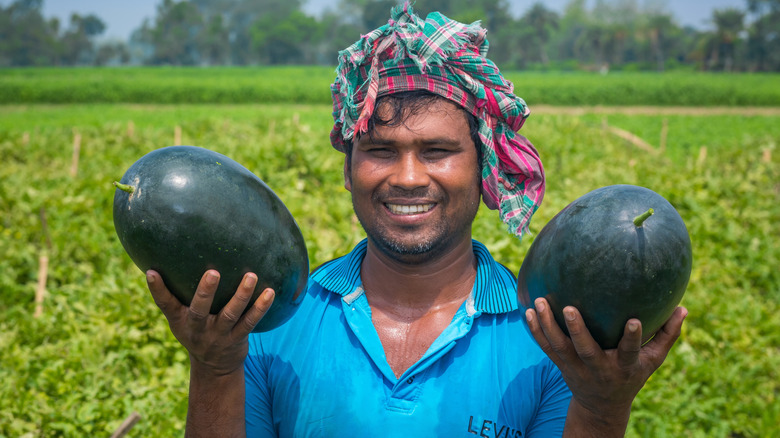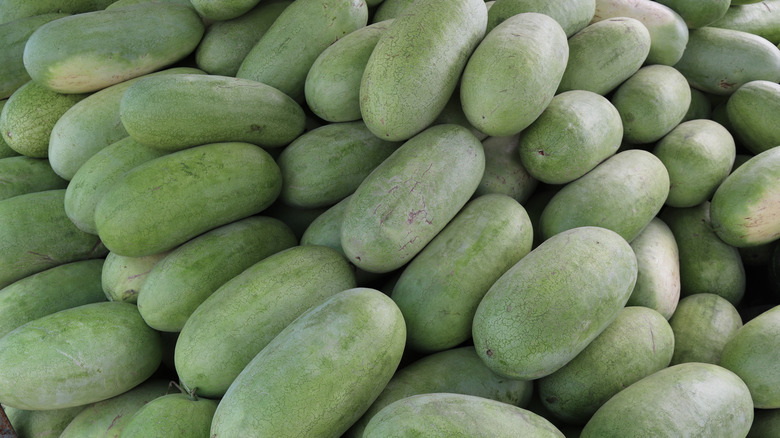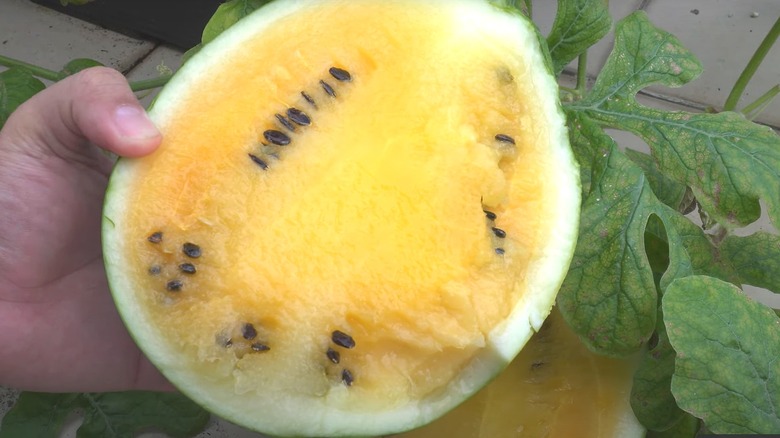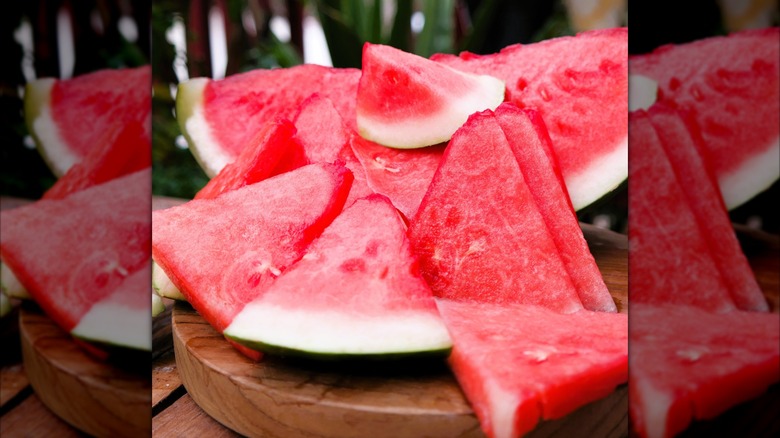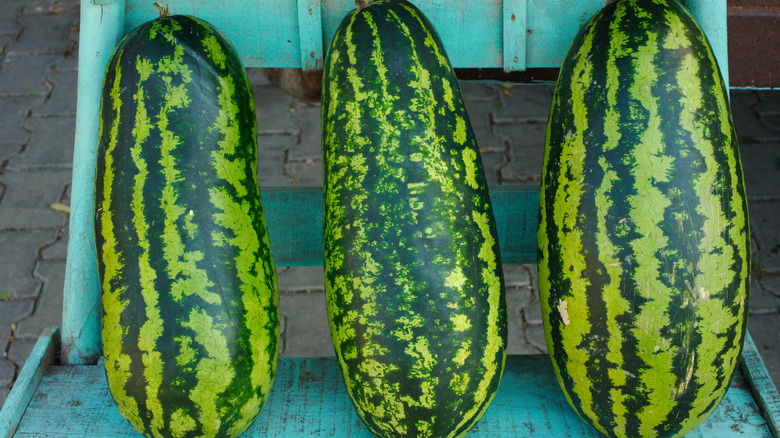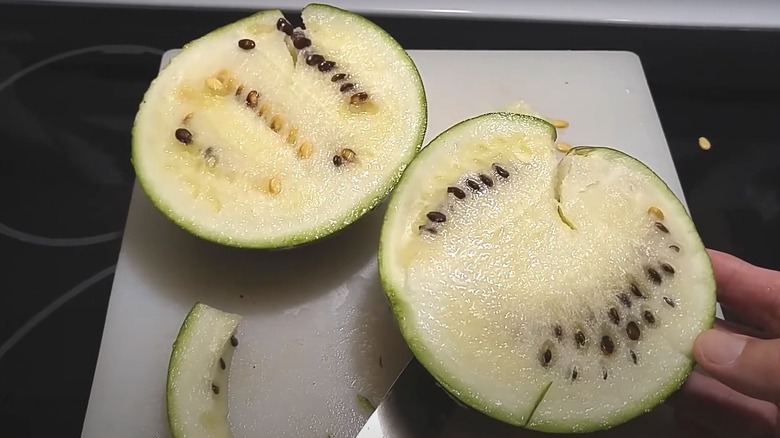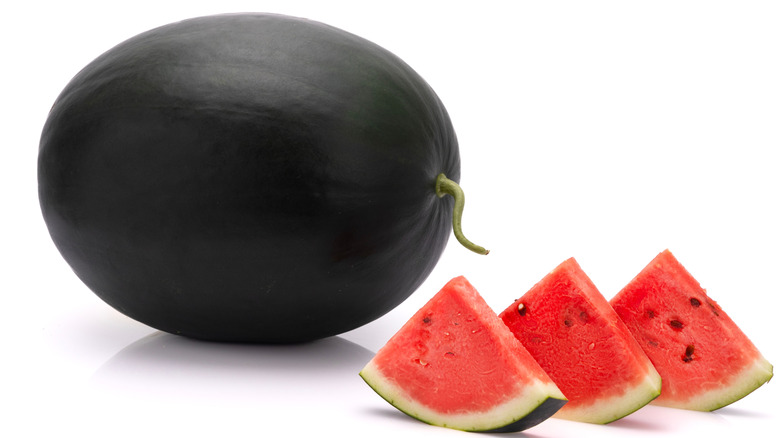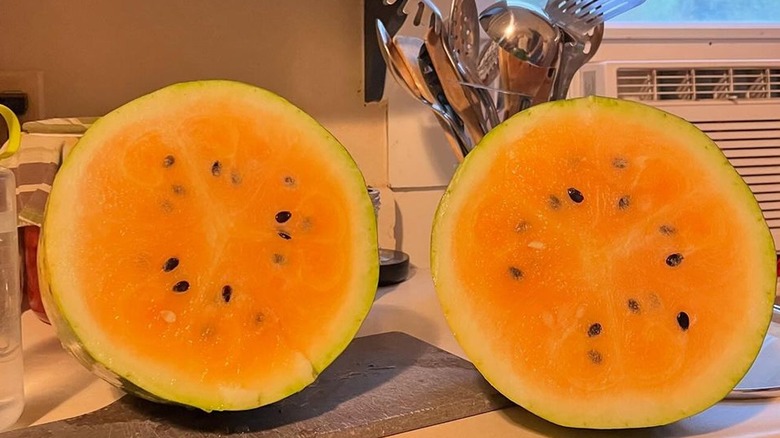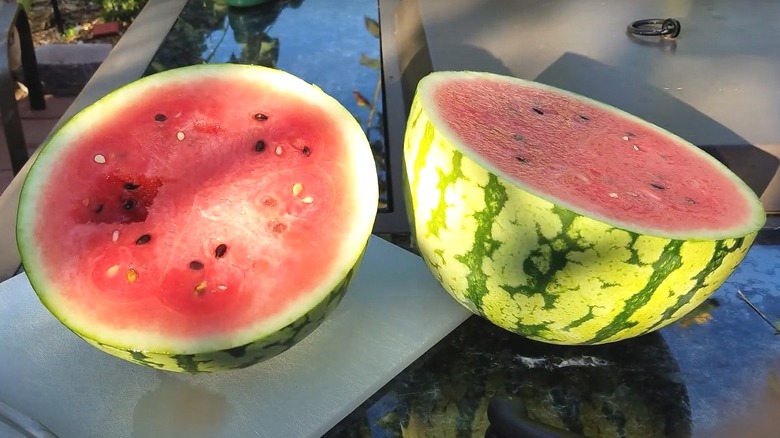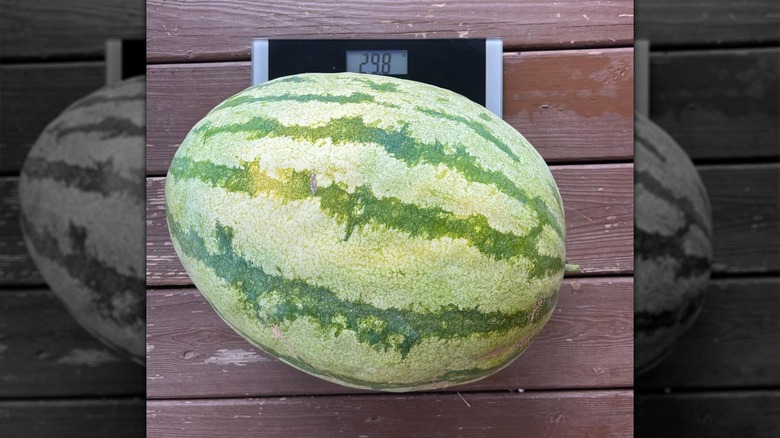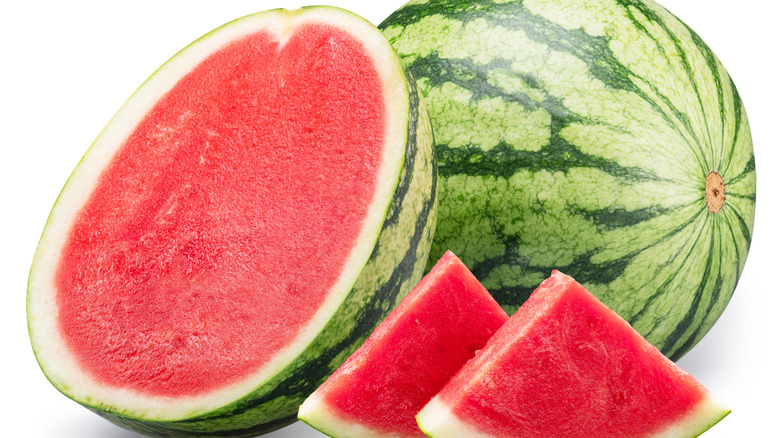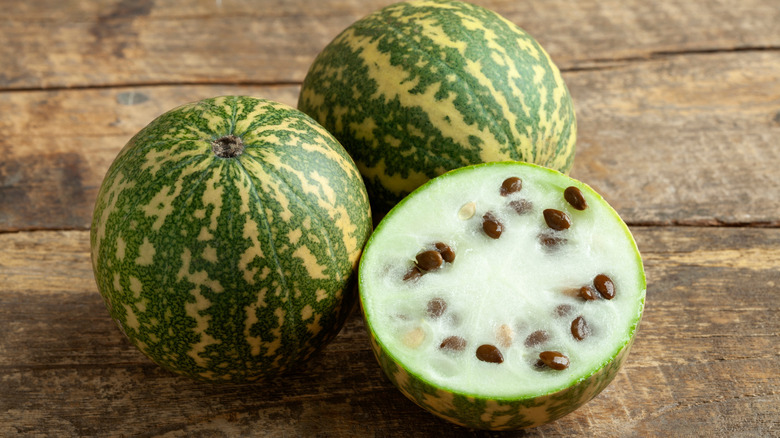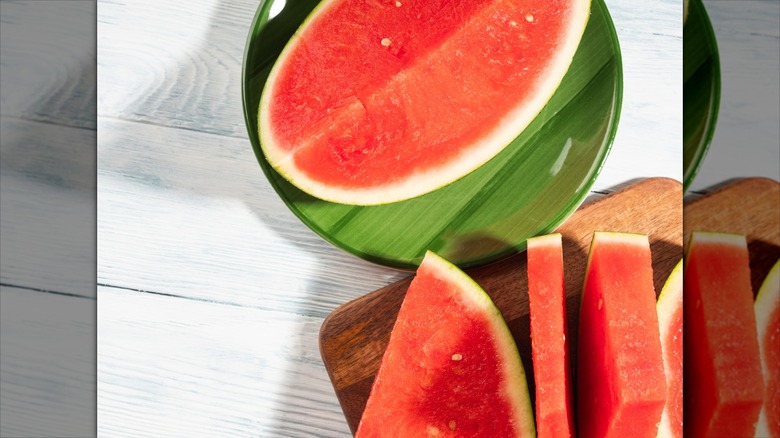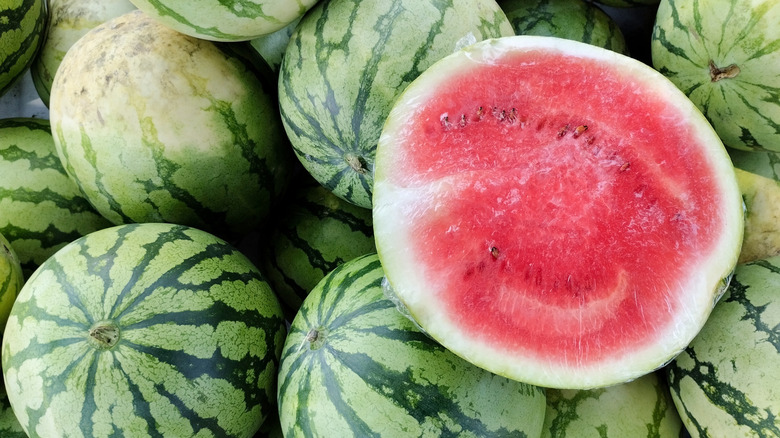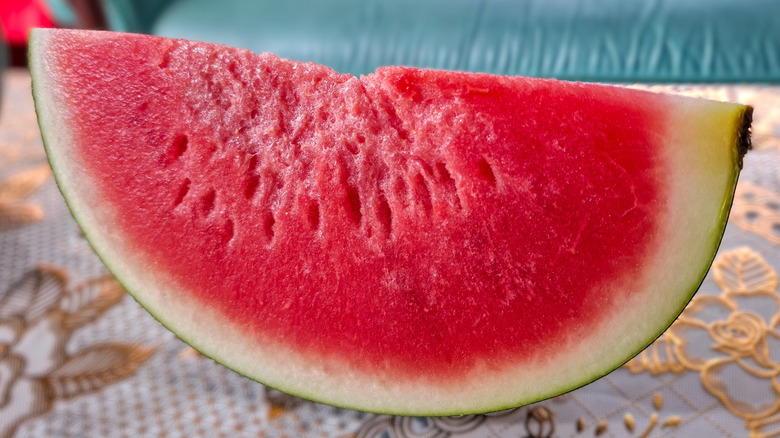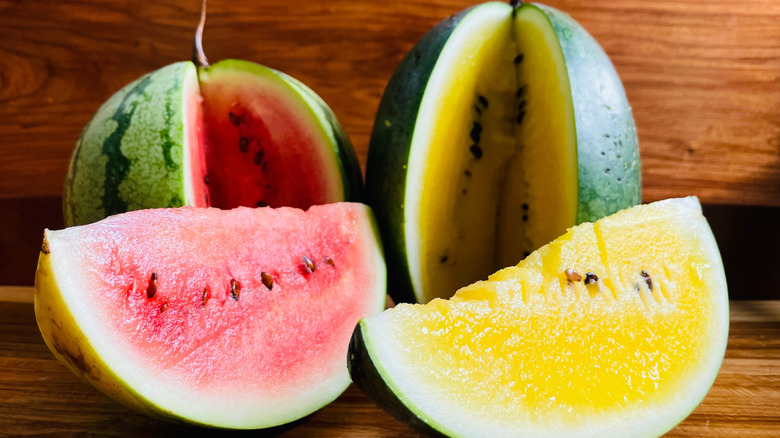19 Varieties Of Watermelon You Should Try
You probably know that there are both seeded and seedless types of watermelon. You might even know some watermelons have yellow flesh instead of the classic red flesh. But did you know that there are actually more than 1,200 varieties of watermelon? However, when you consider that watermelons are grown in nearly 100 countries across the globe, that number seems a bit more understandable.
We didn't have the time to tell you about all 1,200 varieties, so we did some research and compiled a list of 19 varieties. We sought to include several popular varieties in the United States with a diverse selection of sizes, colors, and flavor profiles. Read on to learn more about each of these varieties. Who knows, you might even find a new favorite.
1. Crimson Sweet
When you think about watermelon, you probably picture one with a green rind, deep red flesh, and black seeds. Well, one look at the Crimson Sweet watermelon, and you'll likely find it to be a near-perfect match to what you've been visualizing. This watermelon, which has been a favorite across the U.S. for decades, is frequently cited as the standard for a "good" watermelon when assessing other varieties.
The watermelon has a rounded, slightly oval shape with a striped light and dark green rind. It takes 85 to 88 days to grow to an average size of 20 to 25 pounds. If you try growing this fruit at home, don't forget to use the two-finger rule to check if the watermelon is ready to pick. If two of your fingers fit between the stripes, then it should be ready to pick and enjoy.
2. Little Baby Flower
If you hold off on buying watermelon because you worry too much a huge 20-plus pound melon will go to waste, then the Little Baby Flower might just be the perfect variety for you to try. Weighing between 2 and 4 pounds, it is the perfect size for those who live alone or anyone who doesn't want to deal with cutting a huge melon.
This variety features a slightly oblong, rounded shape with dark green and light green stripes. The interior flesh is dark pink with black seeds. It is rather sugary, so this variety will offer a sweeter taste than some others.
3. Moon and Stars
Moon and Stars watermelon is another variety you might be interested in trying. This melon received its name thanks to the unique pattern on its rind. Instead of the stripes that many other melons feature, it has a darker green rind with several yellow specks and spots. Some of these spots are smaller, while others can be quite large, resembling the moon and stars in the sky.
When you slice the watermelon or find the easiest way to cube it, you'll be greeted by a deliciously sweet pink flesh. There are other variations of the Moon and Stars watermelon with yellow or orange flesh. This variety has a thicker rind and typically grows to weigh between 10 and 15 pounds. However, some gargantuan ones may weigh up to 40 pounds.
4. Orangeglo
Based on the name of this watermelon, it probably won't surprise you to find out that it has orange flesh. When you cut into it, you'll also notice that it has white seeds instead of the more classic black seeds. But the biggest surprise of all will be the flavor. Orangeglo watermelon's taste is reminiscent of that tropical fruit from which it takes its name. It's considered a fairly sweet watermelon sweet and is just right for a cooling treat on a hot summer day.
Orangeglo watermelons can weigh anywhere from 10 to 25 pounds, but some may reach 30 pounds before they're ready to pick. Because of its resistance against pests and other common growing issues, the Orangeglo can also be a good option if you're looking to start growing your own watermelon.
5. Sugar Baby
Sugar Baby. The name says it all. This is a smaller variety (about 7 inches in diameter and weighing up to 12 pounds) with sweet, deep red flesh. The Sugar Baby's rind is free of the stripes found on many other varieties. Instead, it is a solid dark green color.
This melon variety grows a bit quicker than some other types, reaching maturity in about 75 days. It requires full sun, so if you're considering starting a home garden, you'll want to ensure you have the right lighting conditions to grow properly.
6. Charleston Gray
Charleston Gray watermelons are another popular variety you might want to try, particularly if you like seeded watermelon. One thing you'll like about this variety is how refreshing it is. The red flesh is perfectly crisped and free of fibers. The melon features a splotchy, lighter green rind with a medium thickness. Because of this characteristic, you can find several innovative ways to reuse the rind, from pickling it to freezing it for your morning smoothies.
Charleston Gray watermelons were developed by breeders in South Carolina about 70 years ago. If you're thinking of growing your own, make sure you have a spot in your garden that gets full sun. Expect the melons to take about 85 days to mature and grow to a size of about 25 pounds.
7. Yellow Doll
Whether you're looking to try a yellow watermelon or want a smaller, personal-sized option, you might find that the Yellow Doll is the optimal solution. Even better than these characteristics is the fact that this watermelon is exceptionally sweet and perfect for a hot summer day. Plus, since the Yellow Doll watermelon only takes 70 days to reach maturity, you can be snacking on it while other varieties still have two weeks or more to continue growing.
Each melon generally weighs between 5 and 7 pounds. They have a light-and-dark green-striped rind with black seeds to complement the vibrant yellow flesh.
8. Century Star
The Century Star watermelon is another variety you'll be glad you tried. It is ready to harvest after only 75 days after sowing and features a unique rind. It is dark green with gold spots scattered across it. These dots look like stars in a dark sky, hence the watermelon's name.
While the watermelon is visually interesting, you're likely to be even more impressed when you cut into it. It has a vibrant red flesh and is both crisp and sweet — the perfect combination. Eat it right off the rind, or try grilling this delicious summer fruit. These watermelons typically grow to be about 9 to 14 pounds, making them a good size for many families or couples.
9. Jubilee
Looking for a hefty watermelon to feed a crowd? Want to make sure that watermelon tastes as good as it looks? If so, the Jubilee watermelon may be just what you've been hoping to find. This variety typically weighs a whopping 25 to 35 pounds, measuring about 2 feet long by 1 foot wide.
You'll find classic red flesh with black seeds when you cut into a Jubilee watermelon. The watermelon offers a sweet flavor combined with a smooth texture. As you can probably guess, based on its large size, Jubilee watermelons take longer to grow than some other varieties. If you're planning to grow them in your home garden, expect them to take 90 to 95 days (three whole months) to reach maturity before they'll be ready to enjoy.
10. Cream of Saskatchewan
If you haven't tried it yet, you'll want to taste a Cream of Saskatchewan watermelon for no reason other than to say you ate a white watermelon. That's right, this unique variety has a much paler flesh than other types. It has a creamy white color that looks even more striking against its dark black seeds.
Unfortunately, you aren't too likely to find Cream of Saskatchewan watermelons at your local store. This is due to how thin and brittle the rind is and the likelihood that it will become damaged in transport. So, if you want to taste this variety, which weighs in between 5-10 pounds, try checking your local farmers markets or setting up your own home garden to grow it for yourself — it does particularly well grown in northern climates with cooler temperatures, which makes sense as this melon migrated with Russian immigrants to Saskatchewan, Canada, towards the end of the 19th century.
11. Black Diamond
Perhaps the most impressive thing about the Black Diamond watermelon is its size. These melons, full-grown, are at least 30 pounds, with many reaching 50 pounds. In fact, the watermelon, which has been around for decades, is often recommended for use in greased watermelon contests because of its large size and how much fun children (and adults) have while trying to corral it in a swimming pool.
But that is far from all that this melon is good for. Once you cut into it and take a bit of the juicy red flesh, you'll know that it is really best for eating and enjoying. The melon also has black seeds, but don't let them get in the way of enjoying its incredibly sweet flavor.
12. Mountain Sweet Yellow
Based on its name, it should be no surprise to learn that the Mountain Sweet Yellow watermelon has yellow flesh. What you might be surprised by, however, is the flavor. Like many other yellow varieties, the Mountain Sweet Yellow is known for its deliciously sweet taste.
On the outside, Mountain Sweet Yellow watermelons look similar to many other varieties. They have a dark-and-light-green striped rind. The melons typically grow to be 20 to 35 pounds. You may have some leftovers at that size, but don't worry; you can freeze watermelon to enjoy later, as long as you're willing to accept some slight changes to its flavor or texture.
13. Tiger Baby
Tiger Baby watermelons are another smaller variety to consider if you're worried about eating through a 20-, 30, or even 40+ pound melon. They typically weigh around 10 pounds, have dark green and light green "tiger" stripes, and feature bright red flesh.
Tiger Baby watermelons are known for their sweetness. This is also a juicy variety, so be sure to have a napkin or paper towel handy while you enjoy it! If you want to try growing this variety, you might find success if you live in growing zones 4 through 9 and have a full-sun location – growing zones are areas in which the USDA has determined certain plants will thrive. Just note that the Tiger Baby watermelon requires about 80 days to reach maturity.
14. Georgia Rattlesnake
Georgia Rattlesnake watermelons — aptly named because of the resemblance the striped pattern on their rinds bears to rattlesnakes — are another variety that grows to be very large. Most reach a weight of at least 35 pounds, with several hitting 50 pounds, and some reaching a whopping 75 pounds.
This oblong watermelon features red flesh and black seeds. Bite into the flesh, and you won't be disappointed by its sweetness and perfectly crisp texture. In addition to enjoying it off the rind, you could also try infusing tequila with the fruit for a refreshing summer cocktail. This variety has been around far longer than many other types. It was first introduced in Richmond County Georgia during the Civil War.
15. El Capitan
While El Capitan hasn't been around for the decades (or even centuries) that some of the other watermelon varieties in this list have, it is still one you might want to try. First released in 2022, this watermelon features an oval shape and typically weighs between 16 and 20 pounds. It has a dark green rind with some lighter green stripes/splotches across it. Inside, the flesh is deep red.
If you prefer seedless watermelons, this may also be the perfect pick. You won't have to worry about any dark black seeds interfering with your enjoyment of each bite of the smooth flesh.
16. Citron Red Seeded
While the Citron Red Seeded watermelon might look like just another variety when you see the rind, it is another story when you cut into it. This unique watermelon features white flesh with red seeds. However, the distinctive look also comes with a characteristic taste and texture. The flesh is much harder than that of a typical watermelon — about the same consistency as the rind.
Because of this, Citron Red Seeded watermelons aren't overly popular today. However, they were a staple in many homes during the 1800s and early 1900s (and even earlier in history). This is because they would last a long time without preservation or special care. When needed, a family could make them taste better by boiling them and adding sugar. If you can find a local farmer who grows one, you might want to taste the difference (and be glad we have much better preservation methods today).
17. Exclamation
The Exclamation is a sweet and delicious seedless variety that you'll want to sink your teeth into. These melons typically weigh around 20 pounds and have an oval/slightly rounded shape. The rind is dark green with light green stripes and the flesh is a beautiful red color.
This is a variety that you could come across in a local grocery store thanks to the firmness of the rind and its resistance to puncturing during transport. The melons are also pretty uniform in size, which adds to the ease of transporting them.
18. Captivation
Prepared to be captivated by the Captivation watermelon if you can find one — or grow it yourself in a home garden. This hybrid variety is seedless, so while you can't use it for a watermelon seed-spitting contest, you also don't have to worry about eating lots of hard, black seeds.
The melons feature a dark-and-light-green striped rind with a lighter red flesh. If you try growing them yourselves, the rind will fade in color a bit when they are ready to be harvested, which typically takes around 89 days.
19. Harvest Moon
Here's yet another variety with a celestial-inspired name. In fact, the Harvest Moon watermelon has a lot in common with the Moon and Stars variety. They both have a dark green rind with scattered yellow spots, so they are easy to confuse at first glance. However, Harvest Moon watermelons ripen earlier and often deliver a better yield than Moon and Stars watermelons.
You'll also notice a difference when you cut into the watermelon. Not only is the flesh seedless, compared to the black seeds found in Moon and Stars watermelons, but many agree it has a better flavor.
20. Methodology
With more than 1,200 varieties of watermelon out there, we had to be selective about which types we selected for this piece. To start, we tried to ensure that several of our selections were popular in the U.S. with hopes that our readers would come across some of them at a local farmers market. Additionally, we sought to include watermelons with a variety of flesh colors, including some seeded and seedless options.
